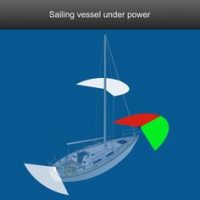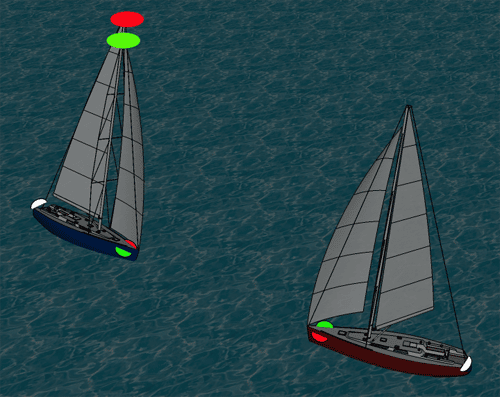1-800-832-7191
Sailboat Lights

Sailboat Lights can be confusing and usually need some explanation.
Common Questions:
Is the tri-color light all I need when under power? Are the red and green lights at the top of the mast all I need? Am I supposed to turn any of these off? How then do I let others know I am under power? If you are under power, you of course need your mast head light illuminated, correct? (As seen here on the left). What if there are no pulpit or stern lights on your vessel? Shouldn’t you always use your mast lights? This is confusing!
Let’s talk it through:
Mast head lights can also be seen on power boats. Take a look at this image shown in the rules. It shows a power-driven vessel longer than 50 meters using two mast head lights.

Here is the definition of a mast head light in the rules:
A “Masthead light” means a white light placed over the fore and aft centerline of the vessel showing an unbroken light over an arc of the horizon of 225 degrees and so fixed as to show the light from right ahead to 22.5 degrees abaft the beam on either side of the vessel.
Note: It does not say the light must be at the top of the mast.
What is the tricolored light for?
Well, it is at or near the top of the mast and is for sailing vessels less than 20 meters or 65.5 feet in length. It is an optional alternative to having the lights down on the hull or pulpits. The tri-color light at the top of the mast faces a white light to the aft 135 degrees plus red from directly forward around to port 112.5 degrees and a green light directly forward and around to starboard 112.5 degrees.
This makes up 360 degrees and meets the requirement for a sailboat sailing.
Options
So, when the sailboat turns on its engines it must also, in addition to the tri-color light at the top of the mast, display a white light 225 degrees facing forward. You can call this light whatever you’d like but it must exist. Now these particular white lights that we preferably call mast head lights, shall be visible from 6 miles. Note: It does not mean they have to be at the top of the mast. On power vessels they are typically at the top of the mast because that is what the mast is for.
Here is a sailing vessel under sail using a tricolored light. There is no forward-facing white light, like in the upper picture, so we know it is under sail.

To clarify, on a sailboat less than 50 meters in length, a white under power mast head light can be just up the mast anywhere. That is to say that it’s not part of the tri color. It is white and faces forward 225 degrees and indicates a sailboat is under power.
Where the confusion lies:
You also might be confusing the term mast head light with the two all-around red and green lights at the top of the mast. These are not mast head lights. They can be used in addition to the hull or pulpit mounted red, green, and white. A sailing vessel cannot display a top of the mast tricolored light AND the two all-around red and green at the top of the mast. Above all, the mast head is white 225 deg forward facing to be used under power only.
Pictured, the Vessel on the left is utilizing the optional two all-around red and green lights. Subsequently, this states that it is under sail or underway and not under engine power.

To further understand this picture, here are the rules as stated:
Rule 25 – Sailing Vessels Underway and Vessels Under Oars
(a) A sailing vessel underway shall exhibit:
(i) sidelights;
(ii) a stern light
(b) In a sailing vessel of less than 20 meters in length, the lights prescribed in Rule 25(a) may be combined in one lantern carried at or near the top of the mast where it can best be seen. [note this is the tricolored light]
(c) A sailing vessel underway may, in addition to the lights prescribed in Rule 25(a), exhibit at or near the top of the mast, where they can best be seen, two all-round lights in a vertical line, the upper being red and the lower green, but these lights shall not be exhibited in conjunction with the combined lantern permitted by Rule 25(b).
In Conclusion:
You can further investigate using the United States Coast Guards book on Navigation Rules… NavRulesAmalgamatedwAnnexes.pdf (uscg.gov)
We are proud to discuss navigation lights in our Public Course please visit our Schedule any time. We teach all of our classes live in a virtual setting